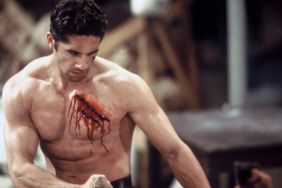Review:
Crime boss Viggo Tarasov (“The Girl with the Dragon Tattoo’s” Michael Nyqvist) has just given his son Iosef (“Game of Thrones'” Alfie Allen) a vicious beating, the kind that in most Russian mob dealings would be followed by a pair of cement shoes. Why treat his son and heir apparent this way? There’s no better explanation than Viggo’s own: “You killed John Wick’s dog and stole his car.”
That is intentionally as absurd as it sounds, especially when repeated (it is, frequently) and punctuated with an understated “Oh” from the perpetrator. That’s because “John Wick” (Reeves) used to be the mob’s best hit man, an assassin so swift and terrifying he became known among the underworld as the Boogeyman, and whose skills will shortly be brought to bear on killers of said dog and obtainers of said car. It’s like “Taken” with a dog.
There is literally nothing else to “John Wick” and that’s kind of okay.
The action sequences were refreshingly staged with an eye not so much towards realism as to avoiding action sequence clichés. The cars do not explode when they drive off bridges, the guns frequently (and frustratingly) run out of bullets and the hand-to-hand tends to quickly devolve to rolling and grappling on the ground. It feels like a long time stunt coordinator turned director checking off a list of action movie don’ts which have plagued him over the years. Considering it is the first film for former stuntman Chad Stahelski, that might not be far off.
It’s also fully cognizant of the silliness of its plot, winking to the camera just enough to be funny without being silly.
That said, while it has a sense of humor (an incredibly dry one), it’s not parody, which is not necessarily a good thing, because it’s not much of anything else either. While doing away with much of the material that they has obviously found offensive in action movies over the years, the filmmakers have not replaced it with anything else. “John Wick” is not so much an action movie as a collection of fast driving action sequences somewhat loosely connected together. It’s like one of Luc Besson’s EuroPop action confections–all dash and style–but without the need to constantly reinforce its machismo through ridiculous dialogue. Instead “Wick” does it the old fashioned way, through violence. Silent, silent violence since no one talks much.
Which is good because if the speak for more than a few sentences it gets very silly, very quickly, especially the functionally mute Wick who’s one extended monologue is probably the worst thing in the film. It’s also a little heavy handed on the emotional tugging, the way a lot of first films are. Though as with the dialogue, that doesn’t happen often as mostly it just cares about sending bullets flying.
“Wick” is as you would expect, all style and no substance, not even a hint of one, which does put a cap on things. What it does, it does well, but its ambitions are incredibly limited. The only parts of “Wick” which seem to exceed those ambitions are its spectacular cast, a who’s who of charismatic character actors who show up to do one scene and then vanish, never to be heard from again. You get the sense everyone is just showing up and having fun and filming it, and that infectiousness is palpable through the lens.
It doesn’t make “Wick” a good movie by any stretch of the imagination, but it is a frequently enjoyable one, and that helps some.
John Wick
-
John Wick

-
John Wick

-
John Wick

-
John Wick

-
John Wick

-
John Wick

-
John Wick

-
John Wick

-
John Wick

-
John Wick

-
John Wick

-
John Wick

-
John Wick











